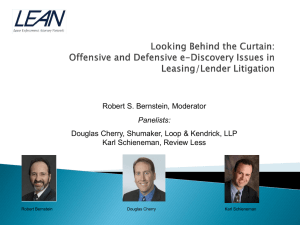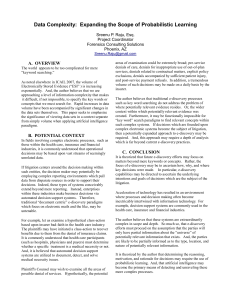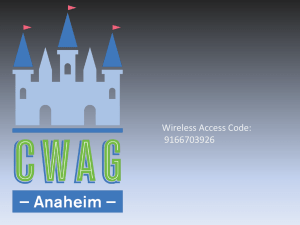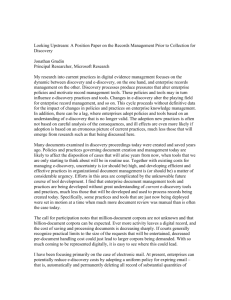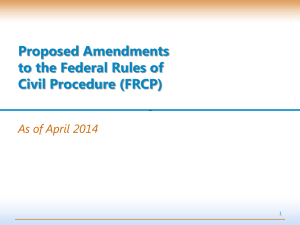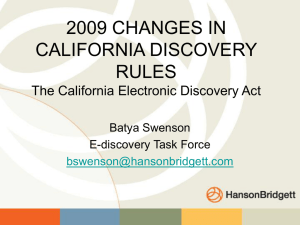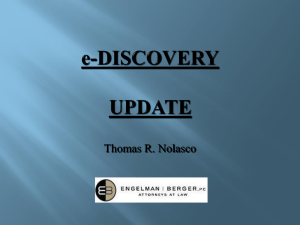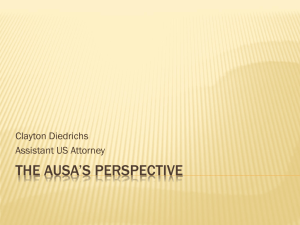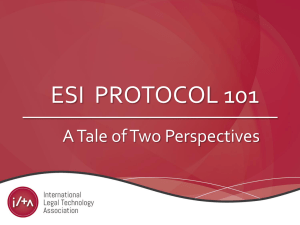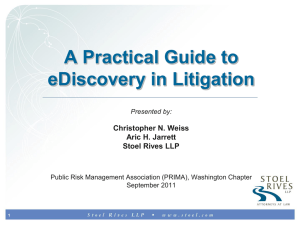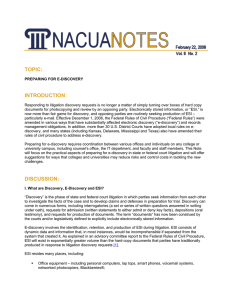Preparing for a Conference Pursuant to Federal
advertisement
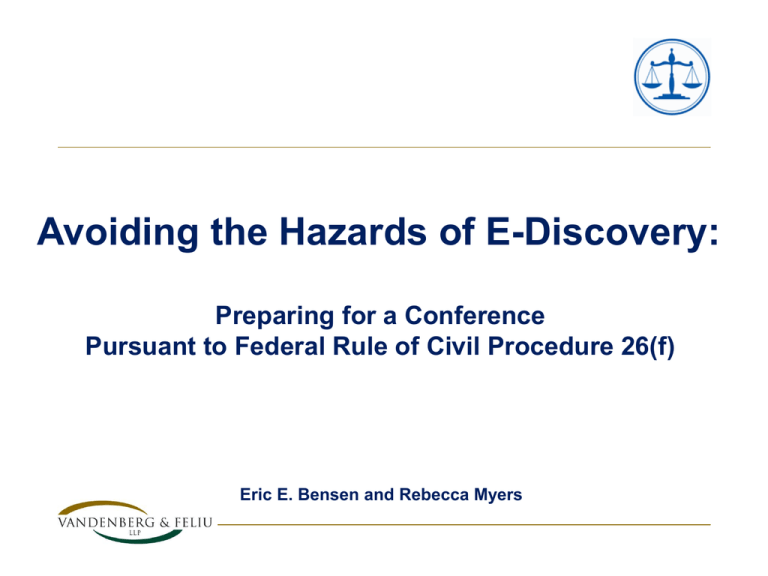
Avoiding the Hazards of E-Discovery: Preparing for a Conference Pursuant to Federal Rule of Civil Procedure 26(f) Eric E. Bensen and Rebecca Myers Overview 1. E-Discovery Overview 2. Preparing for the 26(f) Conference 3. Topics to Discuss at the 26(f) Conference 4. After the Conference 1 I. E-Discovery Overview Environmental litigation takes many forms. The approach to discovery in these different actions will take many forms as well. Toxic Tort Litigation Enforcement and Defense of Environmental Issues Criminal Prosecution Citizen Suits CERCLA, RCRA, CWA Regulatory and Permitting 1 I. E-Discovery Overview • Some flexibility for eDiscovery, e.g.: – edocuments need not be produced in more than one form. – No need to produce if not reasonably accessible because of undue cost. – Party may select method of preserving documents. – No penalty for loss due to routine, good faith operations of electronic system. – Duty to preserve is fact intensive inquiry. • Moreover, cooperation is emphasized – Sharing information and working collaboratively to address e-discovery challenges is a focal point for Judges. – Cooperation has become integral in e-discovery pilot programs, standing orders and judicial decisions. 3 I. E-Discovery Overview • But: E-Discovery carries significant responsibilities and the potential for sanctions: – Anticipation of Litigation = Duty to Preserve – Duty to Preserve + Relevance + Negligence = Sanctions – Duty to Preserve + Willfulness = Sanctions • Available Sanctions (nonexclusive): – Deeming Facts Admitted (FRCP 37(b)(2)(A)) – Precluding Evidence (FRCP 37(c)(1)) – Striking Privilege Assertions (FRCP 26(b)(5)) – Striking Designated Witnesses (FRCP 37(c)(1)) – Monetary Sanctions (FRCP 37(b)) 4 I. E-Discovery Overview Amendments to the Rules as they apply to ESI are currently underway FRCP 37(e) “Failure to Preserve” section has been a focal point and was hotly debated during the public comment period on amendment proposals that ran from Aug. 2013-Feb. 2014. – FRCP 37(e) has caused parties to over-collect and over-preserve in fear of sanctions – Very costly – Standard needs to be one of reasonableness, not strict liability At the last Advisory Committee meeting (Apr. 10-11, 2014), a new version of FRCP 37(e) was introduced. It is restricted to losses of ESI, drops the list of “factors” for courts to employ and ignores existing Rule 37(e). On May 29th and 30th, the Standing Committee is scheduled to review the Advisory Committee’s recommendations, after which the proposals (if approved) will be submitted to the Judicial Conference and Supreme Court. The earliest that any FRCP amendments could go into effect is December 1, 2015. 5 I. E-Discovery Overview Being prepared for E-Discovery is key (Don’t fall behind!) 6 I. E-Discovery Overview F.R.C.P. 26(f) Generally: Requires that all parties confer “as soon as practicable—and in any event at least 21 days before a scheduling conference is set” to: 1. Discuss the nature and basis of their claims and defenses; 2. discuss the possibilities for promptly settling or resolving the case; 3. arrange for the disclosures required by Rule 26(a)(1); 4. discuss any issues about preserving discoverable information; and, 5. develop a proposed discovery plan. 7 I. E-Discovery Overview F.R.C.P. 26(f) ESI: The parties should be prepared, prior to the meet-andconfer discussions, to discuss: 1. The specific data sources in their respective electronic systems. 2. The reasonableness of e-discovery of these data sources. 3. Stipulations regarding ESI discovery plans that encompass an evaluation of the “proportionality factors” (an evaluation performed by the parties themselves at the outset of the discovery phase). 8 II. Preparing for the 26(f) Conference 1. 2. 3. 4. Issuing the Litigation Hold Identify and Speak with Key Players Understanding the Client’s Systems Understanding the Client’s Systems - Backups 9 II. Preparing for the 26(f) Conference Litigation Holds Litigation Holds “The scope of a party’s preservation obligation can be described as follows: Once a party reasonably anticipates litigation, it must suspend its routine document retention/ destruction policy and put in place a “litigation hold” to ensure the preservation of relevant documents.” Zubulake v. UBS Warburg, 220 F.R.D. 212 (S.D.N.Y. 2003) (Zubukake IV) 10 II. Preparing for the 26(f) Conference Litigation Holds Issue a Litigation Hold (i.e., a Document Preservation Notice) • Identify: – – – – – Categories of documents to be preserved Time period Business units effected Sources subject to the hold (e.g., backup tapes, home computers) Exceptions to routine procedures (e.g., suspension to routine deletions) • Issue to: Key players, their staffs, pertinent department heads and, IT personnel responsible for pertinent systems. • Follow up: – Send regular reminders to key players and departments – Have HR and IT provide notice of pertinent personnel changes. • Document the steps taken. 11 II. Preparing for the 26(f) Conference Identify and Speak with Key Players • Who are they key players and how do they store their information? – Anything on home computers, laptops, tablet computers? • What kinds of relevant documents have they created? E.g., – – – – – – – – Audio recordings, voicemail Hazmat related information (invoices, transportation manifests) Proprietary Systems and Databases Social Media Internet use history Lab analysis Modeling data Project plans, specs, drawings 12 II. Preparing for the 26(f) Conference Identify and Speak with Key Players • Who else might have potentially responsive information or documents? – Are there relevant shared documents? – Third-parties? 13 Things II. Preparing You MUST for theKnow: 26(f) Conference Understanding the Client’s Systems • Who are the key IT people, and their roles? • What are the company’s data retention policies? – Are the policies applied and followed consistently? – Has any potentially relevant data been inadvertently destroyed or overwritten? • What applications are used by custodians and for what purpose? • What are the best ways to find and access relevant data? • What format is data usually stored in? 14 II. Preparing for the 26(f) Conference Understanding the Client’s Systems – Backup Systems • Are any backup systems available? – If so, how are those systems accessed? – What is the backup schedule? Is it followed? – Do they contain unique data? • What would be the approximate costs of restoration or recovery, if necessary? 15 II. Topics to Discuss at the 26 (f) Conference Top 10 Topics Parties should be prepared to discuss 16 II. Topics to Discuss at the 26(f) Conference e 1. Litigation Hold and Retention • Confirm that litigation holds are in effect. – As of when? • Scope of hold – – – – – – “Mirror images” of hardware? Geographic or business units subject to hold Servers? Laptops? Home computers? Backup tapes and inaccessible materials? Suspension of deletion and media recycling Cross-border discovery: check local laws! • Duration of hold 17 II. Topics to Discuss at the 26(f) Conference Information 2. Systems and Sources of Electronically Stored Information • Disclosures about locations and types of electronically stored information – – – – Start with email applications, but don’t stop there Proprietary databases Permit applications Paper files • Schedule for additional disclosures or follow up? • Is either side requesting an on-site inspection? – If so, establish protocols 18 II. Topics to Discuss at the 26(f) Conference 3. Scope of Discovery • The scope of discovery – Relevant time period for discovery – Limits on number of custodians – Limits on sources of data – Limits on locations – Discovery from agents under the parties’ control 19 II. Topics to Discuss at the 26(f) Conference 4. Inaccessible Data • Discuss any possible data that may be inaccessible. This can be of particular importance in environmental litigations that possibly reach back decades or longer – – – – – – – – Basis for claim that it is inaccessible What is the data? Is it unique? How much is there? Is it likely to be important or relevant? How can it be recovered? How much would recovery cost, and how long would it take? Beyond backup tapes: legacy systems, deleted data 20 II. Topics to Discuss at the 26(f) Conference 5. Protocols for Finding Responsive Documents • Manual review? – May be overall unreliable and miss many relevant documents. Also, an enormous volume of data may make human review impractical. – Could be best choice when dealing with a dispute involving a narrow, limited scope. • Keyword searching? – Uses terms and/or Boolean searches to locate particular words or phrases in documents. – If using keywords, seek agreement on terms or deadline to exchange terms. – The results can be overinclusive, returning many “false hits.” – But the results can also be underinclusive, and will not capture all relevant documents. 21 II. Topics to Discuss at the 26(f) Conference 5. Protocols for Finding Responsive Documents • Predictive Coding – Concept searching is designed to find and categorize documents based on concept similarity, not merely on the words they contain. – Uses computer technology, linguistics, and mathematical models. – Getting a lot of attention. – Early reports say it increases efficiencies and decreases cost/time. – Some clients/attorneys still wary of the technology. 22 II. Topics to Discuss at the 26(f) Conference 5. Protocols for Finding Responsive Documents • No matter what process you use, the document review & production must: – Be constructed with efficient and effective processes – meet a “reasonableness” standard – be defensible • In reality, a defensible process, well-conceived and executed, is imperative to reducing expenses and it minimizes risk. 23 II. Topics to Discuss at the 26(f) Conference 6. File Formats and How to Produce Documents • The formats in which ESI will be produced. • Format may be different for structured and unstructured ESI – Structured: database, collaboration sites, etc. – Unstructured : email, presentations, word processing, etc. • The extent, if any, to which metadata will be produced and the fields of metadata to be produced. 24 II. Topics to Discuss at the 26(f) Conference 7. Proportionality and Cost Savings • The amount and nature of the claims being made by either party. • The nature and scope of burdens associated with the proposed preservation and discovery of ESI. • The likely benefit of the proposed discovery. 25 7. Topics II. Proportionality to Discussand at the Cost-Savings 26(f) Conference 7. Proportionality and Cost Savings • Costs that the parties will share to reduce overall discovery expenses, such as the use of a common electronic discovery vendor or a shared document repository, or other cost-saving measures. • Limits on the scope of preservation or other costsaving measures. 26 II. Topics to Discuss at the 26(f) Conference 6. 8. Privilege and Confidentiality Issues • Do the parties want a confidentiality agreement? – Bring a proposal to the conference, if possible – Attorneys’ eyes only? – Outside counsel only? – Procedures to challenge designations? – Third parties can be bound? 27 II. Topics to Discuss at the 26(f) Conference 8. Privilege and Confidentiality Issues • Effect of Federal Rule of Evidence 502 • Do the parties want to use a “clawback” or a “quick peek” arrangement? – “Clawback” allows the parties to retract inadvertently-disclosed, privileged documents. – A “quick peek” provision requires parties to produce documents first and assert privilege claims later. 28 9. Topics II. Phasing to Discuss and Timeframes at the 26(f)forConference Disclosure 9. Phasing and Timeframes for Disclosure • Should discovery of ESI be conducted in phases? • The parties should discuss: – Sources of ESI most likely to contain discoverable information that will be included in the first phases of Fed. R. Civ. P. 34 document discovery (e.g., email, reports). – Sources of ESI less likely to contain discoverable information from which discovery will be postponed or avoided. 29 II. Topics to Discuss at the 26(f) Conference 9. Phasing and Timeframes for Disclosure • The parties should discuss: – Custodians (by name or role) most likely to have discoverable information and whose ESI will be included in the first phases of document discovery. – Custodians (by name or role) less likely to have discoverable information and from whom discovery of ESI will be postponed or avoided. – The time period during which discoverable information was most likely to have been created or received. 30 II. Topics to Discuss at the 26(f) Conference 10. Application of Federal and Local Rules • Number and duration of depositions • Interrogatories • Rule 30(b)(6) depositions on document preservation and collection? • Limitations on expert discovery? – Drafts – Communications with testifying experts 31 III. After the Conference • Submit a report of the Rule 26(f) conference to the court within 14 days – Describe the agreements reached, and plans made, by the parties at the conference – Judges are stressing and encouraging cooperation, particularly in the eDiscovery stage • Make the required initial disclosures to other parties within 14 days. F . R. C . P. 26(a)(1) ED IV • Attend Rule 16 conference 32 Parting thoughts… • Plan, plan plan!! E-Discovery process is very manageable if you sit down ahead of time and think through the process from preservation to production. • When you are prepared, your case is easier to handle and you can focus on zealously advocating for your client when you have your arms around the process. • Consider adding a specialized E-Discovery lawyer to the litigation team. • Thank you and good luck! © 2014 Vandenberg & Feliu LLP. ebensen@vanfeliu.com rmyers@vanfeliu.com 33 Parting thoughts… Bensen & Myers on Litigation Management Available from LexisNexis Eric E. Bensen Rebecca K. Myers For more information, please visit: www.ericbensen.com 34
